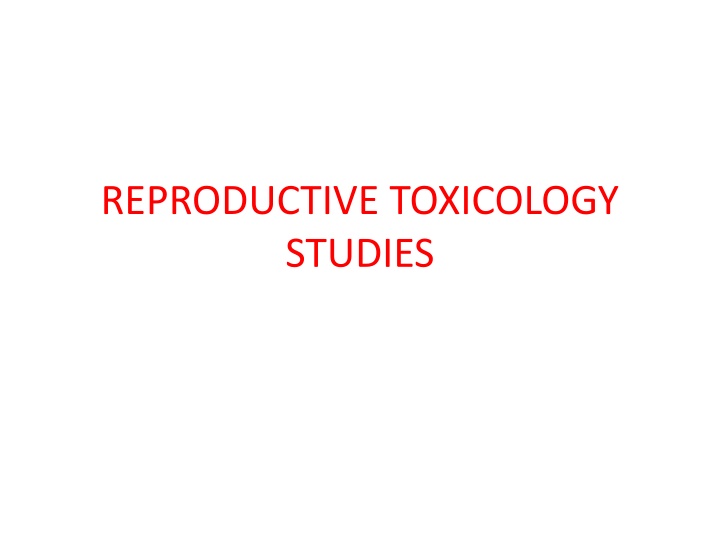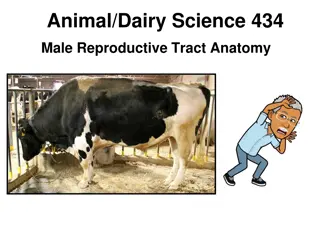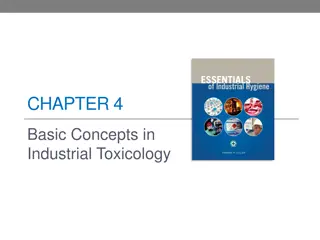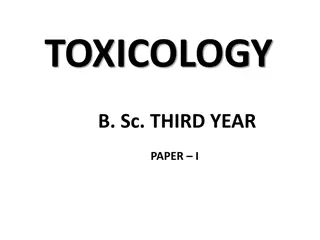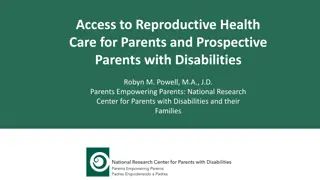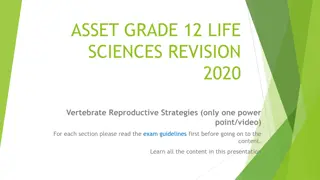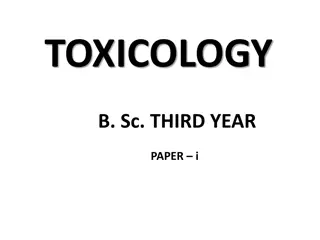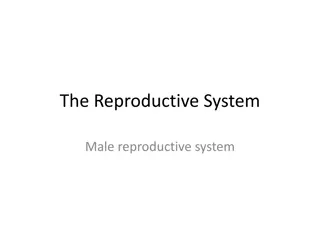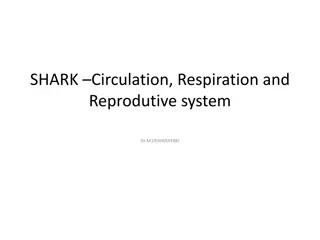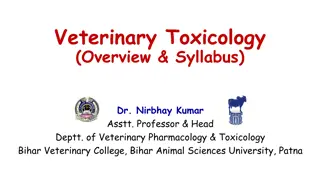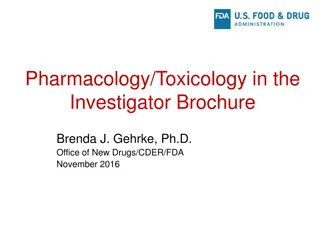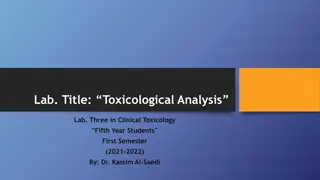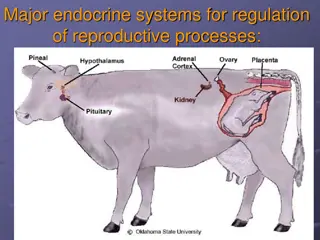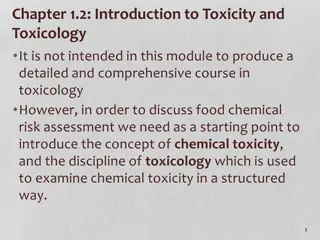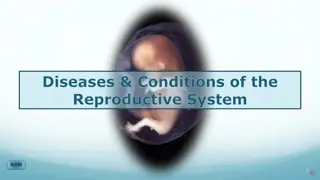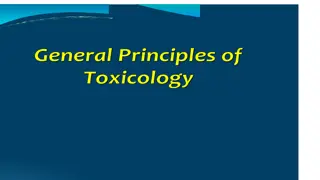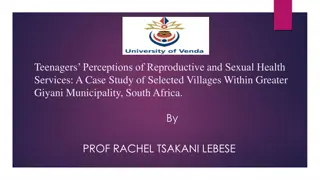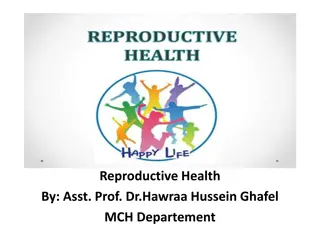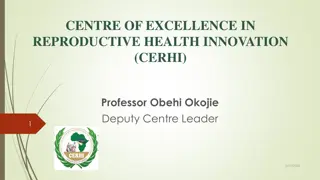Reproductive Toxicology Studies Overview
Reproductive toxicity refers to structural and functional alterations affecting the reproductive system in sexually mature males and females. This includes effects on fertility, sexual behavior, and developmental toxicity. OECD guidelines outline testing principles and methods for assessing reproductive toxicity. The selection of animal species, housing, and feeding conditions are crucial for conducting these studies effectively.
Download Presentation

Please find below an Image/Link to download the presentation.
The content on the website is provided AS IS for your information and personal use only. It may not be sold, licensed, or shared on other websites without obtaining consent from the author.If you encounter any issues during the download, it is possible that the publisher has removed the file from their server.
You are allowed to download the files provided on this website for personal or commercial use, subject to the condition that they are used lawfully. All files are the property of their respective owners.
The content on the website is provided AS IS for your information and personal use only. It may not be sold, licensed, or shared on other websites without obtaining consent from the author.
E N D
Presentation Transcript
REPRODUCTIVE TOXICOLOGY STUDIES
REPRODUCTIVE TOXICOLOGY STUDIES OECD GUIDELINES :422 WHAT IS REPRODUCTIVE TOXICOLOGY? Reproductive toxicity refers to structural and functional alterations that affect reproductive system in sexually mature males and females. Reproductive toxicity includes effects on male fertility and female fertility and lactation.
. Two major class Reproductive toxicity : Effects on sexual behavior and fertility in males and non- pregnant females Developmental toxicity: abnormal structure or functional development following exposure of pregnant or lactating females
. OECD guideline for testing of chemicals on reproductive toxicology Principle of the test: The test chemical is administered in graduated doses to several groups of males and females. Males should be dosed for a minimum of four weeks and up to and including the day before scheduled kill pre-mating dosing period in males, fertility may not be a particular sensitive indicator of testicular toxicity. Therefore, a detailed histological examination of the testes is essential.
. Histopathology of the male gonads, is considered sufficient to enable detection of the majority of effects on male fertility and spermatogenesis. Females should be dosed throughout the study. This includes mating, the duration of pregnancy and at least thirteen days after delivery, up to and including the day before scheduled kill. Duration of study, following acclimatization and pre- dosing oestrous cycle evaluation, is dependent on the female performance and is approximately 63 day. [at least 14 days pre-mating, (up to) 14 days mating, 22 days gestation, 13 days lactation].
. DESCRIPTION OF THE METHOD Selection of animal species Guideline is designed for use with the rat. The rat was the only species used. The test animals should be characterized as to species, strain, sex, weight and age. Weight variation of animals used should be minimal and not exceed 20% of the mean weight of each sex. animals from the same strain and source are used in both studies
. Housing and feeding The temperature in the experimental animal room should be 22 C ( 3). relative humidity should be at least 30% Lighting should be artificial, the photoperiod being 12 hours light, 12 hours dark For feeding, laboratory diets used with an unlimited supply of drinking water. no more than five animals should be housed per cage. Pregnant females should be caged individually and provided with nesting materials. Lactating females will be caged individually with their offspring.
. Preparation of the animals Healthy young adult animals are randomly assigned to the control and treatment groups. Cages should be arranged in such a way that possible effects due to cage placement are minimized. The animals are uniquely identified and kept in their cages for at least five days prior to the start of the study to allow for acclimatization to the laboratory conditions Preparation of doses The test chemical is dissolved or suspended in a suitable vehicle
. PROCEDURE Number and sex of animals It is recommended that each group be started with at least 10 males and 12-13 females. Dosage Generally, at least three test groups and a control group should be used. Dose levels may be based on information from acute toxicity tests or on results from repeated dose studies. If a vehicle is used in administering the test chemical, the control group should receive the vehicle in the highest volume used. Dose levels should be selected taking into account any existing toxicity and (toxico-) kinetic data available.
. Administration of doses The animals are dosed with the test chemical daily for 7 days a week. The volume should not exceed 1 ml/100 g body weight, except in the case of aqueous solutions where 2 ml/100 g body weight may be used. For test chemical administered via the diet or drinking water, it is important to ensure that the quantities of the test chemical involved do not interfere with normal nutrition or water balance. When the test.
. Experimental schedule Dosing of both sexes should begin at least 2 weeks prior to mating, females have been screened for normal oestrous cycles . The study should be scheduled in such a way that oestrous cycle evaluation begins soon after the animals have attained full sexual maturity. This may vary slightly for different strains of rats in different laboratories, e.g. Sprague Dawley rats 10 weeks of age, Wistar rats about 12 weeks of age.
. Dams with offspring should be killed on day 13 post- partum, or shortly thereafter. In order to allow for overnight fasting of dams prior to blood collection (if this option is preferred), dams and their offspring need not necessarily be killed on the same day. The day of birth (viz. when parturition is complete) is defined as day 0 post- partum Dosing is continued in both sexes during the mating period. Males should further be dosed after the mating period at least until the minimum total dosing period of 28 days has been completed.
. They are then killed, or, alternatively, are retained and continued to be dosed for the possible conduction of a second mating if considered appropriate. Daily dosing of the parental females should continue throughout pregnancy. Mating procedure Normally, 1:1 (one male to one female) matings should be used in this study. Each morning the females should be examined for the presence of sperm or a vaginal plug. Day 0 of pregnancy is defined as the day on which mating evidence is confirmed.
. Clinical observation Throughout observations should be made at least once a day, and more frequently when signs of toxicity are observed. They should be made preferably at the same time(s) each day. all signs of toxicity, including mortality, should be recorded. These records should include time of onset, degree and duration of toxicity signs. the test period, general clinical
. Body weight and food/water consumption Males and females should be weighed on the first day of dosing, at least weekly thereafter, and at termination. During pregnancy, females should be weighed on days 0, 7, 14 and 20. Oestrous cycles Estrous cycles should be monitored before treatment starts to select for the study females with regular cycle. Vaginal smears should also be monitored daily from the beginning of the treatment period until evidence of mating.
. If there is concern about acute stress effects that could alter estrous cycles. Offspring parameters The duration of gestation should be recorded and is calculated from day 0 of pregnancy. any abnormal behaviour of the offspring should be recorded
. Clinical biochemistry Blood samples from a defined site are taken. Plasma samples determination should be obtained at a comparable time of the day. The numerical value hormone concentration . Pathology Gross necropsy At the time of sacrifice or death during the study, the adult animals should be examined macroscopically for any abnormalities or pathological changes. specifically for hormone obtained when analysing
. Vaginal smears should be examined in the morning on the day of necropsy to determine the stage of the oestrous cycle and histopathology of ovaries. The testes and epididymides of all male adult animals should be weighed. Histopathology Histological examination should be performed on the ovaries, testes and epididymides of the animals of the highest dose group and the control group.
. DATA AND REPORTING Individual animal data should be provided. Aditionally, all data should be summarised in tabular form, showing for each test group the number of animals at the start of the test, the number of animals found dead during the test or killed the time of any death or humane kill, the number of fertile animals, the number of pregnant females, the number of animals showing signs of toxicity, a description of the signs of toxicity observed.
. Evaluation of results The findings of this toxicity study should be evaluated in terms of the observed effects, necropsy and microscopic findings. Test report Test chemical: source, limit date for use, if available stability of the test chemical physical appearance, water solubility, and physicochemical properties; Vehicle additional relevant
. Test animals: species/strain used; number, age and sex of animals source, housing conditions, diet, etc. individual weights of animals at the start of the test. Results: body weight/body weight changes; food consumption, and water consumption if available; toxic response data by sex and dose, including fertility, gestation, and any other signs of toxicity;
. Reproductive Toxicology studies A) Male fertility Method one rodent species(rat) 3 dose group taken (each 6 adult males) Drug treatment by clinical route for 28-72days Mixed with female in 1:2 ratio
. Female getting pregnant should be examined after 13 days of gestation All male animals sacrificed weights of testis, epididymus recorded and examined for their histology sperms examined for motility and morphology
. Segment I : fertility and general reproductive performance study Segment II: Teratogenicity Segment III: Perinatal and post-natal study perinatal : fertility and early embryonic development . Post-natal development survival of offspring) growth parameter, vital senses, behavioral effect (rat) (post natal
. B) Female fertility (SEGMENT I): The study should be done in one rodent species (rat preferred). The drug should be administered to both males and females, beginning a sufficient number of days (28 days in males and 14 days in females) before mating. Drug treatment should continue during mating and, subsequently, during the gestation period.
. Three graded doses should be used, the highest dose (usually the MTD obtained from previous systemic toxicity studies) should not affect general health of the parent animals, At least 15 males and 15 females should be used per dose group. Control and the treated groups should be of similar size. The route of administration should be the same as intended for therapeutic use. Dams should be allowed to litter and their medication should be continued till the weaning of pups.
. Observations on body weight, food intake, clinical signs of intoxication, mating behaviour, progress of gestation! parturition periods, length of gestation, parturition, post-partum health and gross pathology (and histopathology of affected organs) of dams should be recorded. The pups from both treated and control groups should be observed for general signs of intoxication, sex- wise distribution in different treatment groups, body weight, growth parameters, examination, and autopsy. Histopathology of affected organs should be done. survival, gross
